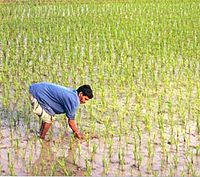
Photo from wikipedia
Soil organic carbon (SOC) plays a critical role in carbon cycling and soil quality of agroecosystems. Understanding the factors influencing SOC and the main indicators for soil quality can help… Click to show full abstract
Soil organic carbon (SOC) plays a critical role in carbon cycling and soil quality of agroecosystems. Understanding the factors influencing SOC and the main indicators for soil quality can help in better soil management and sustainable agriculture. In this study, we selected three upland fields (U1, U2 and U3) and three paddy fields (P1, P2 and P3) of saline-alkali agroecosystems to study the impacts of soil physico-chemical properties (soil pH, exchangeable sodium percentage, electrical conductivity and bulk density) and enzyme activities (soil amylase, invertase, catalase and polyphenol oxidase) on SOC dynamics. The soil pH and exchangeable sodium percentage (ESP) had profoundly negative effect on SOC. Soil amylase and invertase activities were significantly positively correlated with SOC in both upland and paddy fields. Catalase promoted the accumulation of paddy SOC and polyphenol oxidase led to the acceleration of decomposition of upland SOC. Additionally, we combined SOC contents, soil physico-chemical properties and soil enzyme activities together to obtain the main indicators of soil quality. The results suggested that, in upland sites, the main factors affecting the soil quality were soil pH, ESP and SOC. As for paddy sites, the main indicators of soil quality were soil pH, amylase and invertase. By comparing the soil quality indicators between upland and paddy fields, it was observed that the inhibiting effect of ESP on paddy soil quality was not as significant as on upland soil quality due to the irrigation practice of rice planting, which could reduce the degree of soil alkalization. Therefore, paddy development has been widely used to improve the saline-alkali land in western Jilin Province of China.
Journal Title: Sustainability
Year Published: 2018
Link to full text (if available)
Share on Social Media: Sign Up to like & get
recommendations!